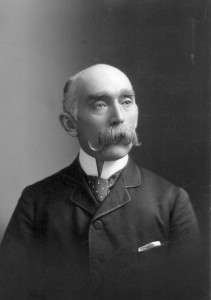Peter Bryce
| Peter Bryce | |
|---|---|
 Dr. Bryce (1890) | |
| Born |
August 17, 1853 Mount Pleasant, Ontario |
| Died |
January 15, 1932 (aged 78) At sea near West Indies |
| Resting place | Beechwood Cemetery |
| Scientific career | |
| Fields | Public health |
Peter Henderson Bryce (August 17, 1853 – January 15, 1932) was an official of the Ontario Health Department, Canada. As a public official he submitted reports that highlighted the mistreatment of Indigenous students in the Canadian Indian residential school system and advocated for the improvement of environmental conditions at the schools.
Biography
Peter Bryce was born in Mount Pleasant, Ontario on August 17, 1853.[1] He obtained his medical degree from the University of Toronto, where he studied natural science geology, and went on to study neurology in Paris. He lectured for a time at the Ontario Agricultural College in Guelph, Ontario in science and applied chemistry.[2] Bryce served as the first secretary of the Ontario Board of Health from 1882 to 1904, when he was appointed the Chief Medical Officer of the federal Department of Immigration.[1][3]
Bryce was hired by Indian Affairs Department in Ottawa to report on the health conditions of the Canadian residential school system in western Canada and British Columbia. His report was never released by the government but was published by Bryce in 1922 under the title The Story of a National Crime: Being a Record of the Health Conditions of the Indians of Canada from 1904 to 1921.
Bryce claimed that Indigenous children enrolled in residential schools were deprived of adequate medical attention and sanitary living conditions. He suggested improvements to national policies regarding the care and education of Indigenous peoples.[4][5] In a 1907 report Bryce cited an average mortality rate of between 14% and 24% at the schools and a shocking 42% infant mortality rate on the reserves, this due to sick children being sent home to die.[6]:9 Bryce noted that the lack of certainty about the exact number of deaths was, in part, due to the official reports submitted by school principals and "defective way in which the returns had been made."[7]:405
He appealed his forced retirement from the Civil Service in 1921 and was denied, subsequently publishing his suppressed report condemning the treatment of the Indigenous at the hands of the BNA.[8]
Bryce died on January 15, 1932 while travelling in the West Indies.[9] He is buried at Beechwood Cemetery in Ottawa.[10]
Publication
- "The duty of the public in dealing with tuberculosis" (Microform). 27 October 1898. Retrieved 6 September 2016.
- "Annual Report of the Department of Indian Affairs, for the fiscal year ended 30th June, 1906". University of Toronto - Government Information Collections - Sessional Papers, 1901-1925. Department of Indian Affairs. 1906. pp. 272–284. Retrieved 5 September 2016.
- "The story of a national crime : being an appeal for justice to the Indians of Canada ; the wards of the nation, our allies in the Revolutionary War, our brothers-in-arms in the Great War". Internet Archive. Ottawa: J. Hope. 1922. Retrieved 5 September 2016.
See also
References
- 1 2 FitzGerald, J. G. (February 1932). "DOCTOR PETER H. BRYCE". Canadian Public Health Journal. 23 (2): 88–91. JSTOR 41976579.
- ↑ Lux, Maureen K. (2001). Medicine that walks : disease, medicine, and Canadian Plains native people, 1880 - 1940. Toronto [u.a.]: Univ. of Toronto Press. ISBN 9780802082954. Retrieved 5 September 2016.
- ↑ Dickin, Janice (2013). "Peter Henderson Bryce". thecanadianencyclopedia.com. Historica Canada. Retrieved 5 September 2016.
- ↑ "Honouring the Truth, Reconciling for the Future - Summary of the Final Report of the Truth and Reconciliation Commission of Canada" (PDF). The Truth and Reconciliation Commission of Canada. 31 May 2015. Retrieved 28 June 2016.
- ↑ Sproule-Jones, Megan (1996). "Crusading for the Forgotten: Dr. Peter Bryce, Public Health, and Prairie Native Residential Schools". Canadian Bulletin of Medical History. 13 (2).
- ↑ Hope and Healing: the Legacy of the Indian Residential School System (PDF). Ottawa: Legacy of Hope Foundation. March 2014. ISBN 978-1-77198-002-9. Retrieved 4 May 2017.
- ↑ Truth and Reconciliation Commission (2015). "Canada's Residential Schools: The History, Part 1 Origins to 1939" (PDF). Final Report of the Truth and Reconciliation Commission of Canada Volume 1. National Centre for Truth and Reconciliation. Retrieved 1 July 2016.
- ↑ https://archive.org/stream/storyofnationalc00brycuoft/storyofnationalc00brycuoft_djvu.txt
- ↑ "Who was Dr. Peter Henderson Bryce?". First Nations Child & Family Caring Society. Retrieved 5 September 2016.
- ↑ Deachman, Bruce (14 August 2015). "Beechwood ceremony to honour medical officer's tenacity". Ottawa Citizen. Retrieved 5 September 2016.
External links
"He was a whistleblower, who exposed deadly conditions in residential schools". CBC News. 17 August 2015. Retrieved 6 September 2016.